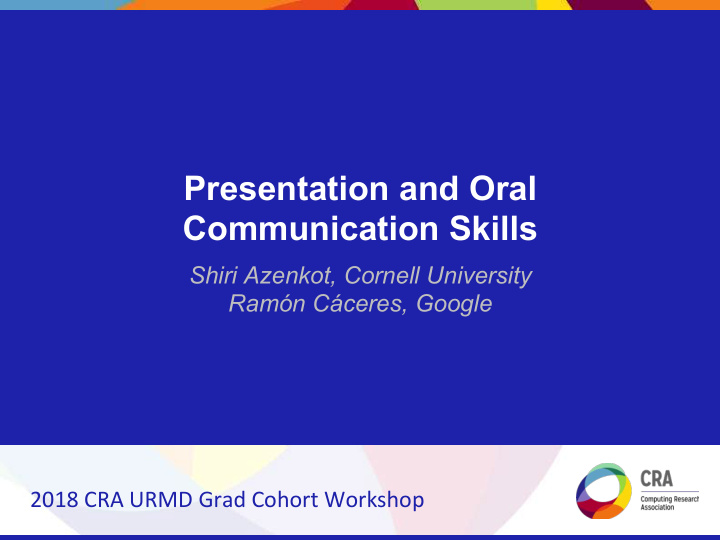



Presentation and Oral Communication Skills Shiri Azenkot, Cornell University Ramón Cáceres, Google 2018 CRA URMD Grad Cohort Workshop
Ramón Cáceres • Grew up in Dominican Republic • BEng in EE from McGill U in Canada • MS in CS from UC Berkeley in CA • Software engineer in Silicon Valley startup: Pyramid • PhD in CS from UC Berkeley in CA • Industrial researcher at AT&T and IBM in NYC area • Startups in NYC along the way: Vindigo, ShieldIP • Software engineer at Google in NYC
Shiri Azenkot • Israel -> San Jose, CA -> Seattle, WA -> New York, NY • BA in computer science, Pomona College • Software engineer, 3 years • MS + PhD in computer science, University of Washington • Assistant Professor of Information Science, Cornell Tech, Cornell University
Why is it important to be a good communicator?
Good communication helps you... • Dissemination • Getting a job • Getting funding • Finding collaborators • Opportunities!
Preparing your presentation
Consider the context • Who’s your audience ? – Colleagues in your research area – Colleagues in your field (e.g., computer science) – Students (high school, PhD students) – Others?
Consider the context • What’s the purpose of your presentation? – To inspire – To inform – To entertain – To impress
Consider the context • What are your constraints ? – Time – Materials (AV) – Size of room and audience
The beginning of the presentation
Script the beginning of your presentation • Begin with a promise – Provides an overview – Captures people’s attention – Generates excitement and interest
What’s your promise? • Think about a recent presentation you gave. • What promise could you use next time you present that work? • Make it concise, relatable, compelling.
Our promise We’re going to tell you about how to prepare and deliver excellent presentations that will help you throughout your career.
Another promise I’m excited to tell you about a system that we designed that helps people with low vision complete an important daily task.
Contents of your presentation
Key content in your presentation 1. What is the problem you’re trying to solve? 2. Why should your audience care? 3. What have others done to try and solve this? 4. What did YOU do? 5. How do you know what you did is good ? 6. What is your contribution?
Planning what you’ll say • Talk to your audience, don’t read to them • Tell the story of your research • Repeat key ideas • Use verbal punctuation • Pause
Design effective supporting materials • Use slides to support you • Incorporate images, videos, and props to help explain your ideas • Speak all text on the slides • Verbally explain visuals and videos • Add captions to videos • Use large fonts • Use clear and minimalist graphics (avoid complexity)
Make your presentation accessible • Speak all text on the slides • Verbally explain visuals and videos • Add captions to videos • Use large fonts • Use clear and minimalist graphics (avoid complexity)
Related Work • Focus on closely related work. Typically many fewer citations in a talk than in a paper. • Compare and contrast the previous work to yours. Don’t just summarize other work. • Stress building upon vs. tearing down.
Wrapping up your talk • Summarize contributions to the state of the art • Mention future directions and open issues • Be strong and positive • Choose your last slide wisely. It tends to be up for a long time during Q&A.
Other advice
Delivery and Confidence • Speak with confidence. You’re the expert. • Face your audience, not the projection screen • Avoid verbal fillers (e.g., um, ah). Silence is OK. • Be aware of your body language
Practice, practice, practice! • Give the talk aloud to yourself – Calibrate your timing – Practice transitions, not just core content • Give the talk to a practice audience – Gather honest feedback – Make changes to address the feedback • Cultivate a community/culture of practice talks
Handling Questions • Answer with confidence. Again, you’re the expert. • But don’t be afraid to say you don’t know. Offer to follow up with the questioner. • You may get persistent questioners. Take discussion offline if it goes on too long. • Don’t take aggressive questions personally. Try to answer the content of the question. • Anticipate likely questions. Prepare backup slides.
Elevator Pitches • There are frequent opportunities to answer the question “What are you working on?” • Have ready a 1-minute pitch about your work • Make it concise and meaningful – Quick motivation / context – Main results so far • Follow up with more detail if there is interest
Summary • Know your audience, purpose, and constraints • Begin with a promise • Tell the story of your research • Visuals are key • Practice
Useful resources • How to Give a Bad Talk https://people.eecs.berkeley.edu/~pattrsn/talks/BadTalk.pdf • Oral Presentation Advice http://pages.cs.wisc.edu/~markhill/conference-talk.html • Out Loud http://randsinrepose.com/archives/out-loud/ • Presentation Zen http://www.presentationzen.com/
Five-minute exercise • 1 minute: Think about your own answer to “What are you working on?” • 1 minute: Pick a partner sitting next to you. • 1 minute: Partner 1 gives answer to Partner 2. • 1 minute: Switch roles.
Presentation and Oral Communication Skills Shiri Azenkot, Cornell University Ramón Cáceres, Google 2018 CRA URMD Grad Cohort Workshop
Recommend
More recommend